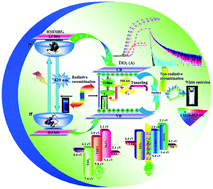White-light emission from HMIMBF4–TiO4(A) colloidal hybrid electrolyte and surface modification of TiO2 using ionic liquid in hybrid optoelectronic devices
Abstract
White-light emission from the colloidal hybrid electrolyte 1-hexyl-3-methylimidazolium tetrafluoroborate (HMIMBF4)–TiO2(A) is discussed herein. The HMIMBF4–TiO2(A) hybrid electrolyte showed an increase in the lifetime as compared to bare anatase TiO2 (TiO2(A)). The blue emission at 420 nm from HMIMBF4 is attributed to the π–π* transition of the imidazolium moiety, and strong green and yellow emissions at 517 and 568 nm, respectively, are due to defect emissions of TiO2 NPs. In the HMIMBF4–TiO2(A) colloidal hybrid electrolyte, the combination of blue emission from the ionic liquid and defect emission from TiO2 NPs produced intense white light. Fabricated HyLEDs showed enhanced device efficiency by the surface modification of rutile TiO2 (TiO2(R)) using HMIMBF4 ionic liquid. HMIMBF4, with a thickness of 250/850 nm, exhibited maximum current efficiency (ηc – cd A−1) of 322.22/361.53, power efficiency (ηp – lm W−1) of 6.2/7.1, external quantum efficiency (ηex – %) of 322.22/361.53 and luminance (ηL – cd m−2) of 70.14/1490.95. Spontaneously aligned dipole polarization within the ionic liquid HMIMBF4 layer reduced the electron injection barrier and led to enhanced device efficiencies.



 Please wait while we load your content...
Please wait while we load your content...